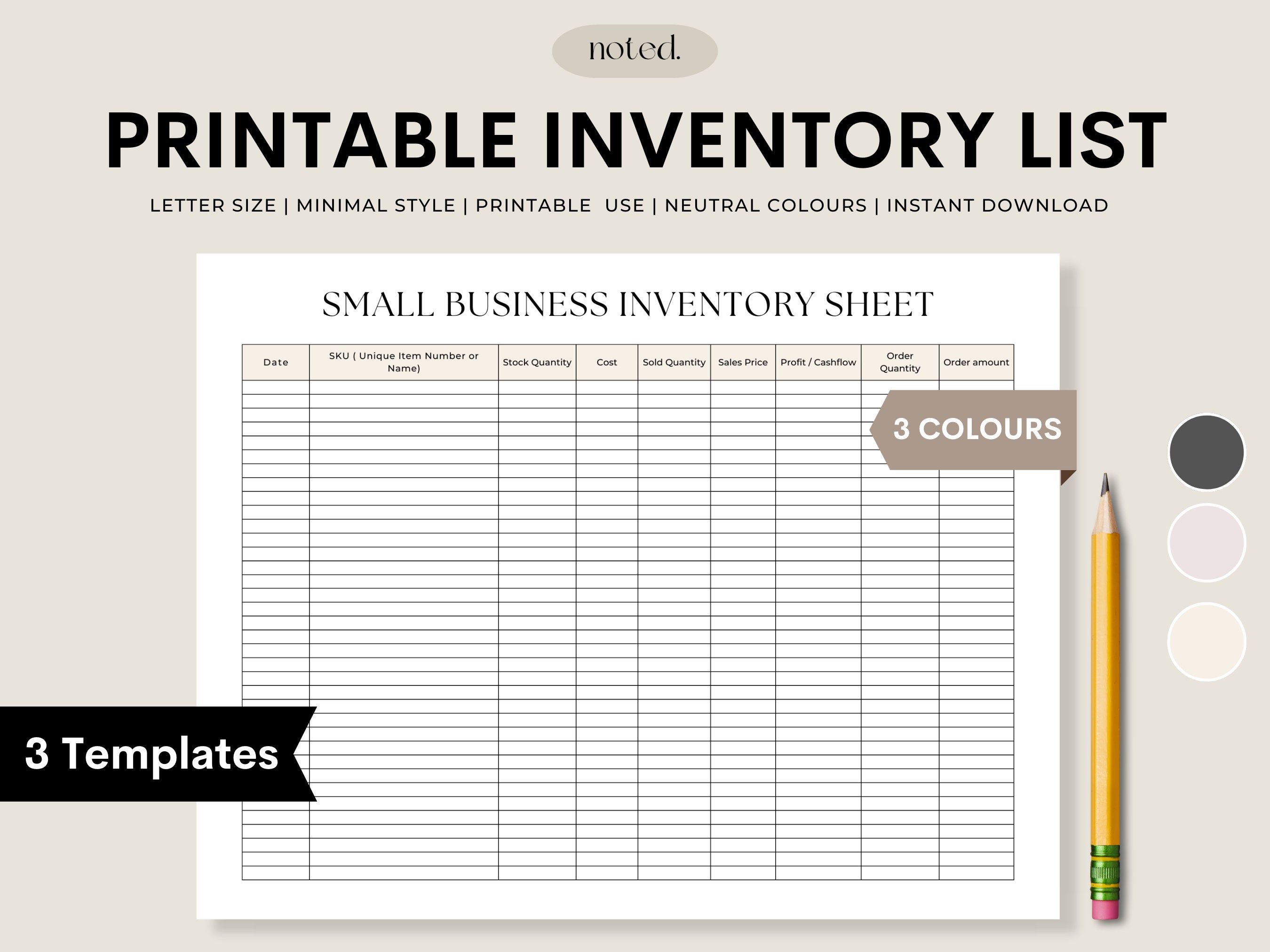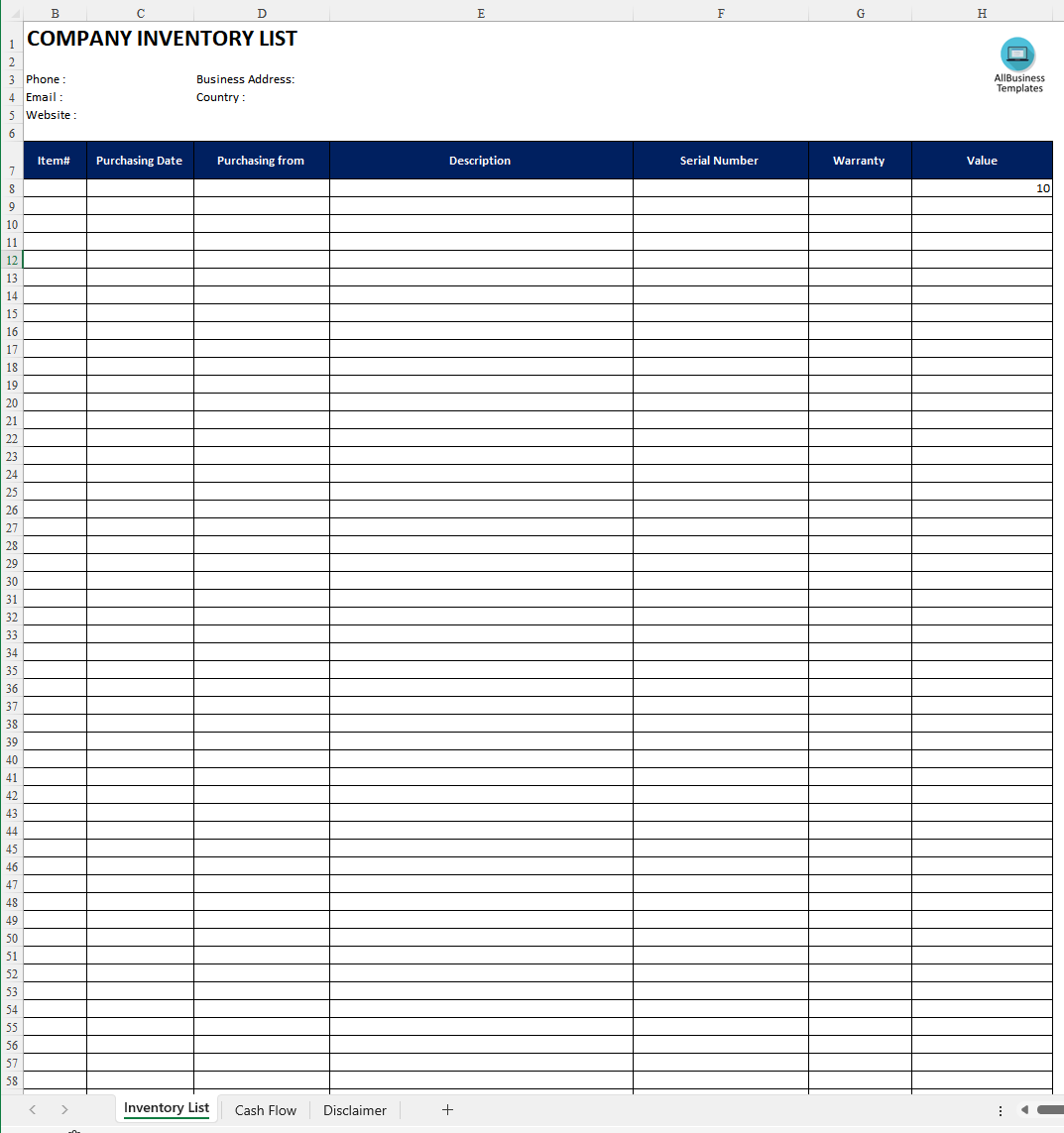
The Unsung Hero of Business Operations: Mastering Your Inventory with a Dedicated List Template
In the dynamic world of business, where efficiency and profitability are paramount, one element often acts as the silent backbone, yet its mismanagement can lead to catastrophic consequences: inventory. Whether you’re a bustling retail store, a meticulous manufacturer, an e-commerce giant, or a small service provider with physical assets, the effective management of your inventory is not merely a task – it’s a strategic imperative. And at the heart of this imperative lies a deceptively simple yet profoundly powerful tool: the Business Inventory List Template.
This article will delve deep into the critical role of inventory management, explore what constitutes an effective inventory list template, detail its myriad benefits, guide you through its creation and implementation, and discuss when it’s time to transition to more sophisticated solutions. Our aim is to equip you with the knowledge to transform your inventory from a potential liability into a significant asset, all while aiming for a comprehensive exploration of approximately 1200 words.
The Indispensable Role of Inventory Management
Before we dissect the template, it’s crucial to understand why inventory management itself is so vital. Inventory is more than just goods on a shelf; it represents a significant investment of capital, directly impacting cash flow, operational efficiency, and ultimately, customer satisfaction.
Consequences of Poor Inventory Management:
- Stockouts: Running out of popular items leads to lost sales, frustrated customers, and damaged brand reputation.
- Overstocking: Tying up capital in excess inventory incurs storage costs, insurance fees, and risks obsolescence, damage, or theft. It also reduces liquidity.
- Inaccurate Data: Decisions based on faulty inventory counts can lead to incorrect purchasing, production delays, and misguided sales strategies.
- Operational Inefficiencies: Wasting time searching for items, dealing with misplaced stock, or manually counting slows down operations significantly.
- Financial Misrepresentation: Inaccurate inventory valuation distorts financial statements, affecting tax obligations, loan applications, and investor confidence.
Conversely, robust inventory management ensures that you have the right products, in the right quantity, at the right time, and in the right place. This balance is key to maximizing sales, minimizing costs, and fostering customer loyalty.
What is a Business Inventory List Template?
A Business Inventory List Template is a pre-formatted document, typically a spreadsheet (like Microsoft Excel or Google Sheets), designed to systematically record and track all the items a business holds. It serves as a foundational tool for organizing inventory data, making it accessible, understandable, and actionable.
Unlike complex inventory management software, a template offers a straightforward, cost-effective, and highly customizable solution, particularly suitable for small to medium-sized businesses (SMBs) or those just beginning to formalize their inventory tracking. Its purpose is to standardize data collection, simplify record-keeping, and provide a clear snapshot of current stock levels and related information.
Key Components of an Effective Inventory List Template
To be truly effective, an inventory list template must capture specific data points that are critical for decision-making. While the exact fields may vary slightly depending on the business type, the following are generally considered essential:
-
Item Identification:
- SKU (Stock Keeping Unit): A unique alphanumeric code assigned to each distinct product or service. SKUs are internal and crucial for tracking, ordering, and sales analysis.
- Item Name/Description: A clear, concise name and brief description of the item. This helps in quick identification and avoids confusion.
- Barcode/UPC (Universal Product Code): While not strictly part of a manual template, including this field allows for future integration with barcode scanners or serves as a reference.
-
Quantity & Location:
- Current Stock Level (Quantity On Hand): The most critical piece of information, indicating how many units of an item are currently available.
- Minimum/Reorder Level: The threshold quantity at which a new order should be placed to avoid stockouts.
- Maximum Stock Level: The highest quantity of an item you wish to hold, helping prevent overstocking.
- Warehouse/Bin Location: Specifies the exact physical location (e.g., Warehouse A, Shelf 3, Bin 12) for efficient retrieval and put-away. Essential for businesses with multiple storage areas.
- Quantity On Order: Number of units that have been ordered but not yet received.
- Quantity Reserved: Number of units allocated for specific orders but not yet shipped.
-
Cost & Pricing:
- Unit Cost: The cost to acquire one unit of the item. Crucial for calculating Cost of Goods Sold (COGS) and profit margins.
- Selling Price: The price at which the item is sold to customers.
- Total Inventory Value (per item): (Current Stock Level x Unit Cost) – useful for quick valuation and financial reporting.
-
Supplier & Order Information:
- Primary Supplier: Name and contact information of the main vendor for the item.
- Supplier Product Code: The supplier’s own identification code for the item, if different from your SKU.
- Lead Time: The estimated time (in days or weeks) it takes for a new order to arrive from the supplier. Critical for setting reorder points.
- Date of Last Order/Receipt: Helps track purchasing patterns and supplier performance.
-
Status & Condition:
- Condition: Indicates the state of the item (e.g., New, Used, Refurbished, Damaged, Expired). Important for quality control and pricing.
- Status: Reflects the item’s availability (e.g., Available, Discontinued, Obsolete, On Hold).
- Date Added/Last Updated: Provides an audit trail and helps identify stale inventory.
-
Category/Department:
- Category: A broader classification (e.g., Electronics, Apparel, Raw Materials, Finished Goods) for better organization, reporting, and analysis.
- Department: If applicable, the department responsible for the item.
By meticulously populating these fields, a business creates a comprehensive and dynamic snapshot of its inventory, transforming raw data into actionable insights.
Benefits of Using a Business Inventory List Template
Implementing and consistently using an inventory list template offers a plethora of advantages that can significantly impact a business’s bottom line and operational health.
-
Improved Accuracy: By standardizing data entry and providing a clear framework, templates significantly reduce the likelihood of human error that often plagues informal or manual tracking systems. This improved accuracy trickles down to better financial reporting, more reliable reorder points, and a clearer understanding of your true stock levels.
-
Enhanced Efficiency: With all inventory information centralized and organized, businesses can drastically cut down on time spent searching for items, verifying stock levels, or cross-referencing disparate records. This leads to faster order fulfillment, quicker stock takes, and more streamlined operations overall.
-
Better Financial Control: A detailed inventory list provides an accurate valuation of your assets, which is crucial for financial statements, tax reporting, and insurance purposes. It helps in calculating the true Cost of Goods Sold (COGS) and understanding profit margins, enabling better budgeting and financial planning.
-
Optimized Stock Levels: By tracking minimum and maximum stock levels, businesses can avoid both the pitfalls of stockouts (lost sales, customer dissatisfaction) and overstocking (carrying costs, obsolescence). This ensures capital is tied up efficiently, maximizing product availability without excessive waste.
-
Informed Decision-Making: The data collected in your template serves as a powerful analytical tool. You can identify best-selling items, slow-moving stock, seasonal trends, and supplier performance. This intelligence empowers you to make data-driven decisions regarding purchasing, pricing, marketing, and even product discontinuation.
-
Streamlined Audits and Compliance: Having a well-maintained inventory list simplifies internal and external audits. It provides a clear, documented record of your stock, making it easier to comply with regulatory requirements and reconcile physical counts with recorded data.
-
Cost Savings: From reduced storage costs due to optimized stock levels, to minimizing losses from spoilage or obsolescence, and avoiding emergency rush orders, a template directly contributes to significant cost reductions across various operational facets.
-
Scalability (as a starting point): While a template has limitations, it provides a structured foundation. As a business grows, the organized data collected in a template makes the transition to more advanced inventory management software much smoother, as the data structure is already established.
How to Create and Implement Your Inventory Template
Creating an effective inventory template doesn’t require advanced technical skills, but it does demand careful planning and consistent execution.
-
Choose Your Platform:
- Microsoft Excel: Widely available, powerful for calculations, filtering, and sorting.
- Google Sheets: Cloud-based, excellent for collaboration, accessible from anywhere.
- Basic Database Software: For slightly more complex needs, though still less robust than dedicated IMS.
-
Define Your Fields (Columns): Based on the "Key Components" section above, create a column for each piece of information you need to track. Be thorough, but avoid unnecessary complexity. Start with the essentials and add more as needed.
-
Populate with Initial Data: This is often the most time-consuming step. Conduct a thorough physical inventory count of all your items. Be meticulous in recording every detail for each item into your template. Assign SKUs if you don’t already have them.
-
Establish a System for Updates: This is critical for maintaining accuracy.
- Frequency: Decide how often entries will be updated (e.g., daily after sales, weekly after receipts).
- Responsibility: Assign clear roles for who is responsible for updating the template (e.g., sales team for outgoing, receiving team for incoming).
- Procedure: Outline the exact steps for adding new items, recording sales, tracking returns, and noting damages.
-
Train Your Team: Ensure everyone involved in inventory (sales, purchasing, warehouse staff) understands how to use the template, the importance of accuracy, and the established update procedures. Consistency is paramount.
-
Conduct Regular Audits: Periodically perform physical inventory counts (cycle counting or full annual counts) and reconcile them with your template data. Investigate and resolve any discrepancies immediately. This process helps identify and correct errors before they snowball.
-
Analyze and Adapt: Don’t just collect data; use it! Regularly review your template to identify trends (e.g., popular items, slow movers, supplier issues). Use this analysis to refine your purchasing strategies, optimize stock levels, and improve overall operations. Be open to adding or removing fields as your business needs evolve.
When to Graduate from a Template to Software
While an inventory list template is an excellent starting point, businesses eventually reach a point where its limitations become apparent. This is usually a sign that it’s time to invest in dedicated Inventory Management Software (IMS).
Indicators it’s time to upgrade:
- High Volume & Complexity: Managing thousands of SKUs, multiple warehouses, or complex bill-of-materials becomes unwieldy with a spreadsheet.
- Real-Time Needs: Templates are not inherently real-time. Businesses requiring instant updates on stock levels across various sales channels will find templates insufficient.
- Integration Requirements: When you need seamless integration with POS systems, e-commerce platforms, accounting software, or CRM systems, a template won’t cut it.
- Advanced Features: Features like automated reorder alerts, batch tracking, serial number tracking, multi-location management, detailed reporting, forecasting, and automated stock valuation are beyond a basic template’s capabilities.
- Scalability Challenges: As your team grows, managing access, version control, and preventing accidental deletions in a shared spreadsheet becomes a nightmare.
- Manual Error Proneness: Despite best efforts, manual data entry remains prone to errors, which an IMS with automation can significantly reduce.
Inventory management software offers greater automation, accuracy, real-time insights, and scalability, allowing businesses to handle growth without compromising efficiency. However, the structured data from a well-maintained template will make the migration to a new system significantly smoother.
Conclusion
The Business Inventory List Template, though seemingly basic, is an incredibly powerful and foundational tool for any enterprise. It transforms the chaotic reality of physical stock into organized, actionable data, laying the groundwork for improved efficiency, enhanced financial control, and ultimately, greater profitability. By meticulously defining its components, diligently implementing its use, and committing to regular updates and audits, businesses can gain unparalleled visibility into their operations.
Embrace the inventory list template not just as a record-keeping device, but as a strategic instrument. It’s the unsung hero that, when properly utilized, empowers businesses to make smarter decisions, delight customers, and secure a stronger, more sustainable future. Start simple, stay consistent, and watch as your inventory transforms from a potential burden into a strategic advantage.

